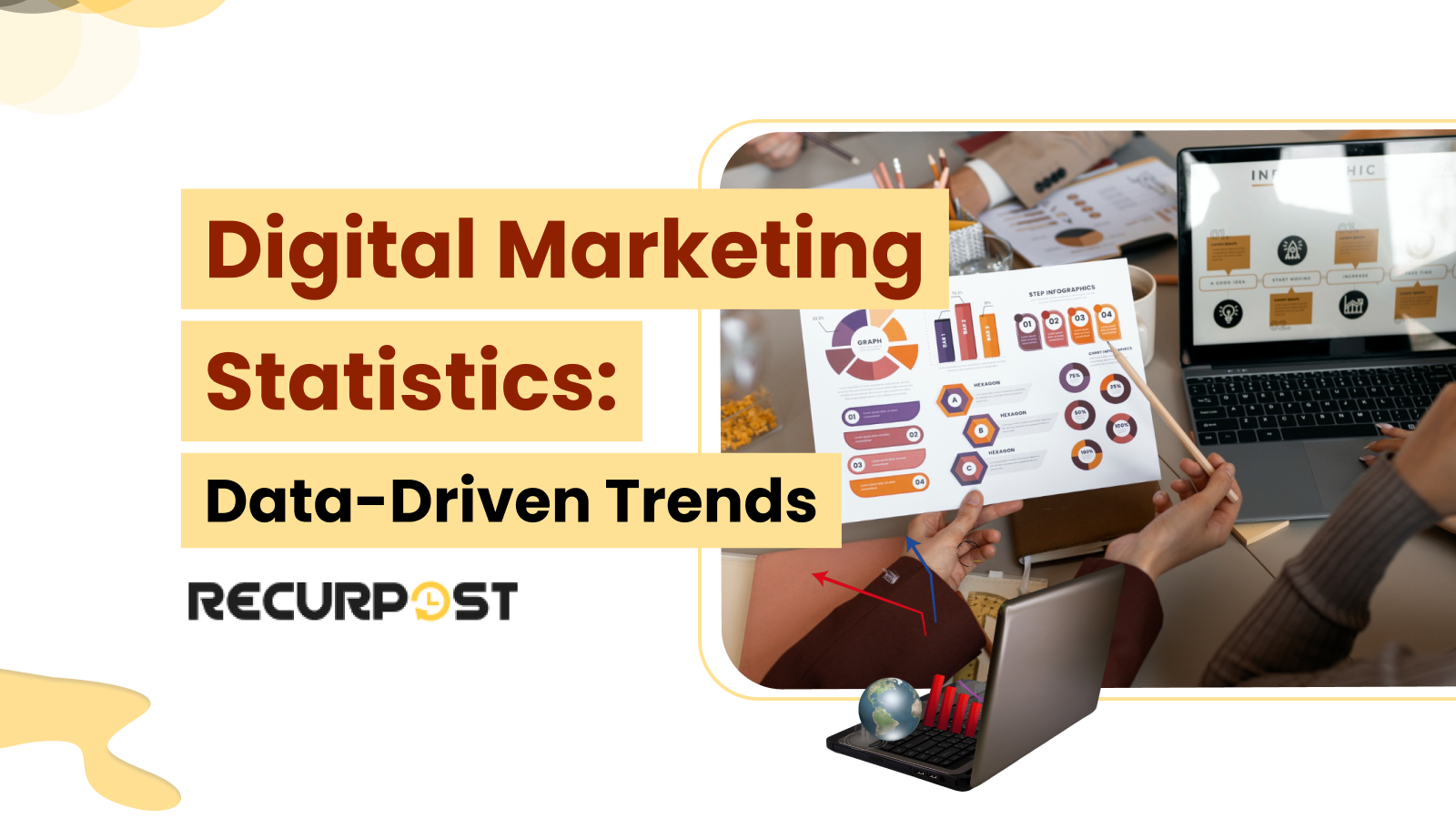Digital marketing relies on data, analysis, and future planning. Its success requires evidence-backed choices. Marketers, small business owners, and data analysts use digital marketing analytics and online marketing metrics to evaluate campaign performance and increase ROI.
Digital channels now receive more budget than traditional ones, demonstrating a significant shift from offline to online marketing. Still old-school media matters – about 73% of internet users find new brands through “offline” channels like TV, print, or radio highlighting the need for a balanced approach.
This outline presents key digital marketing statistics and data-driven trends for 2025 covering social media, email marketing, SEO, content marketing, video, and influencer marketing. Each section includes verified statistics with sources showing how data-driven insights predict future results and shape marketing strategies.
Global Digital Marketing Landscape and ROI
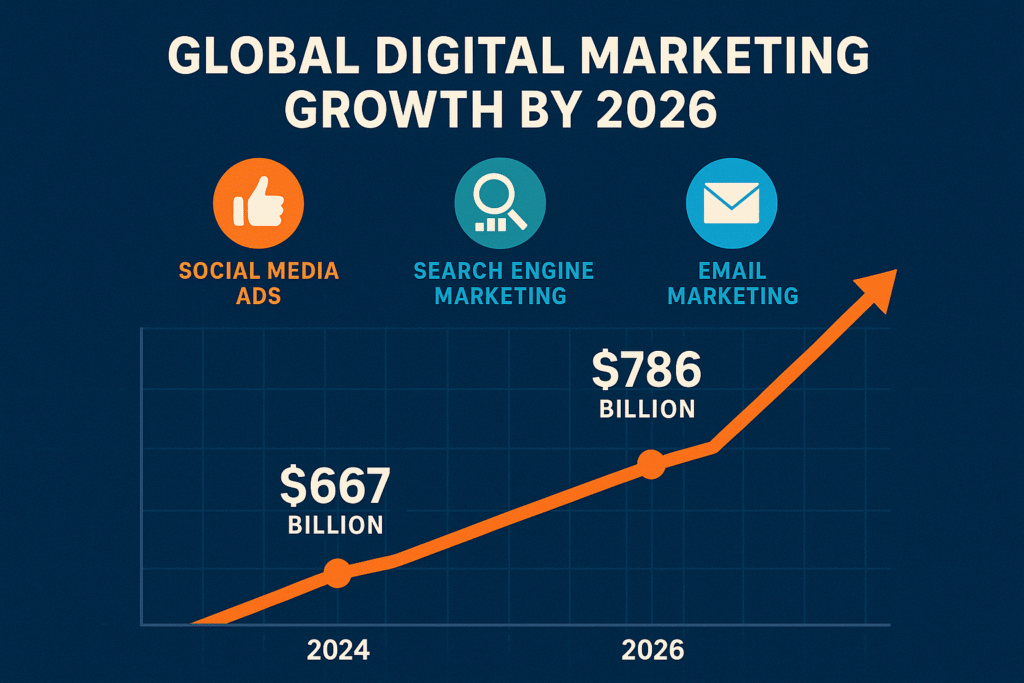
Here’s the overall digital marketing industry size, growth, and how it pays off compared to old-school marketing:
Market Size & Growth
- The global digital advertising and marketing market had a value of $667 billion in 2024 and experts predict it will grow to $786 billion by 2026 (Wordstream).
- Digital ad spending increased by 10% compared to the previous year in 2024, indicating companies continue shifting budgets to online platforms. This matches Statista’s findings that online channels now make up ~72.7% of worldwide ad spend – a significant increase from ~50% in 2018 – as businesses prioritize digital over traditional media (Datareportal).
Digital vs. Traditional Spend
- By the end of 2024, digital channels influenced about 60% of all marketing spend while offline media spend declined (Wordstream).
- In the U.S. online marketing spend grew by 12% in 2024, comprising about 69% of total ad spend. Marketers now allocate more budget to channels like search, social, and video, while traditional marketing (TV, print, radio) represents a smaller portion of spending. (Marketing Charts).
- Overall advertising spend (all channels) reached $1.09 trillion in 2024, but $0.73 of every $1 went to digital formats. (Datareportal).
Return on Investment:
- Data-driven marketing significantly affects ROI. Pay-per-click (PPC) advertising (e.g., Google Ads search) returns about $2 for every $1 spent – a 200% ROI on average. Email marketing generates $36–$40 for every $1 spent, making email one of the highest ROI channels (3600%+ ROI).
- Small businesses say email is their top ROI-driving channel. Organic search (SEO) is also effective: ~49% of businesses say SEO brings the best marketing ROI of any channel.
- Marketers often mention content marketing and SEO together as top ROI strategies. These numbers show that performance metrics matter – they quantify campaign effectiveness and demonstrate marketing value based on evidence.
Digital Marketing Budget Trends:
- About 63% of businesses have increased their digital marketing spending in recent years, and 94% of small businesses plan to spend more on marketing in 2025 (SproutSocial).
- From 2023 to 2024, businesses increased digital marketing budgets by an average of 10%. This increase demonstrates companies’ confidence in data-driven digital strategies for growth (Wordstream).
- Marketing teams are putting money into analytics and tools – the need for digital marketing jobs is expected to grow by about 10% by 2026 (which is higher than average) as companies look for people who can handle these new projects.
Social Media Marketing Statistics & Trends for 2025
Social media marketing dominates in 2025, with billions of active users and evolving trends. Brands leverage social platforms to boost awareness, engagement, and sales.
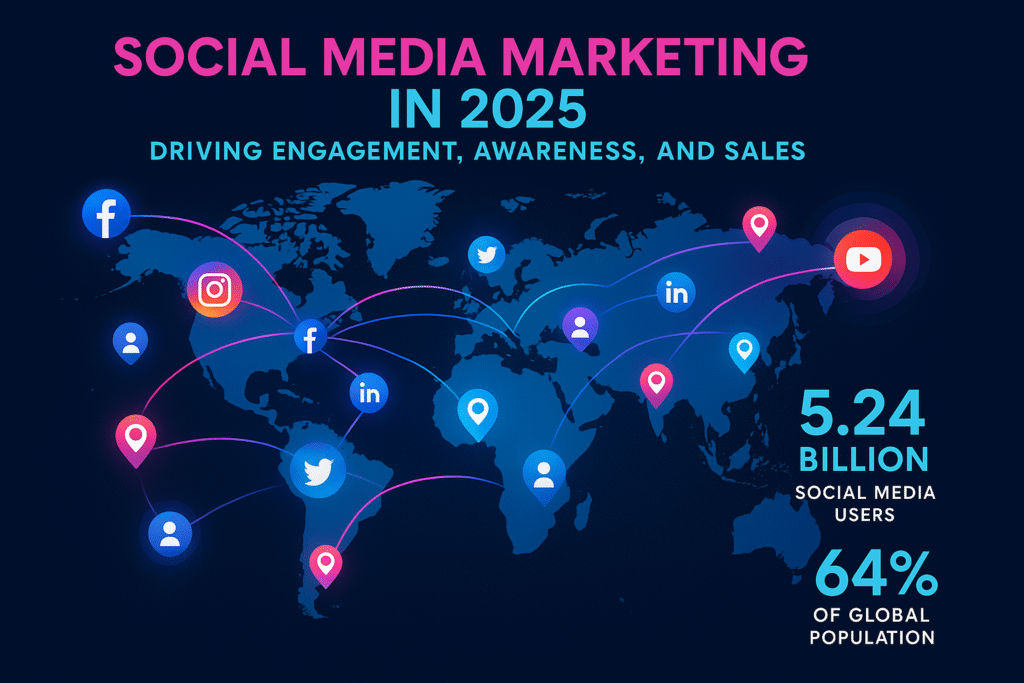
Key stats and trends include:
Global User Base & Usage:
- 5.24 billion people use social media worldwide – 64% of the global population engages with social networks. (HubSpot)
- The typical person spends 2 hours 24 minutes daily on social media, distributed across ~7 different platforms. This large engaged audience makes social media essential to most marketing strategies.
- 91% of companies use social media to market their products or services, and businesses allocate approximately 15% of their marketing budgets to social media activities on average.
Top Platforms & Demographics:
- Facebook remains the top platform for marketers, with over three billion monthly active users (MAU) as of April 2024. It is expected to maintain its position as the most popular social network in 2025. Marketers in 2023 said Facebook gave better ROI than other platforms.
- Instagram has 2 billion active users worldwide and holds high value for influencer campaigns (more on that later) (Statista).
- LinkedIn counts over 1.1 billion members (half of users are 25–34 years old) and leads as the top B2B social channel – 40% of B2B marketers find LinkedIn most effective to generate leads (LinkedIn).
- TikTok has over 1.5 billion monthly active users worldwide, solidifying its place as one of the most popular social media platforms. As of 2024, the platform reached 2.05 billion registered users. (Yellowhead).
Engagement & Content Trends:
- Social media functions as a commerce and discovery channel. Social platforms rank first for product discovery among consumers aged 18–44.
- Engagement strategies focus on community-building – 90% of social marketers consider an active community essential for success.
- Short-form video dominates social media (e.g., TikTok, Instagram Reels): users respond to authentic, entertaining videos. In 2025, short-form video is projected to account for 90% of all internet traffic (Vidico). Also, funny and relatable content works best for brands – 66% of social marketers find humor most effective to engage users.
Social Advertising Performance:
- Facebook Ads benchmarks (2024) reveal an average click-through rate of ~1.5% for traffic campaigns and 2.5% for lead-gen campaigns, with cost-per-click ranging from $0.83 to $1.92 based on campaign type (Wordstream).
- Social media ad spend remains substantial – mobile social media ads alone attract more than $140 billion worldwide. Social ads deliver high ROI: marketers rank paid social among the top 3 ROI drivers for both B2B and B2C brands. As algorithms change, brands also try new formats (like social commerce features and shoppable posts) to boost conversions within apps (HubSpot).
Email Marketing Statistics & Trends for 2025
Email marketing remains impactful and easily measurable in 2025. People often call it a “lifeline” to talk to customers and to grow businesses for small companies.
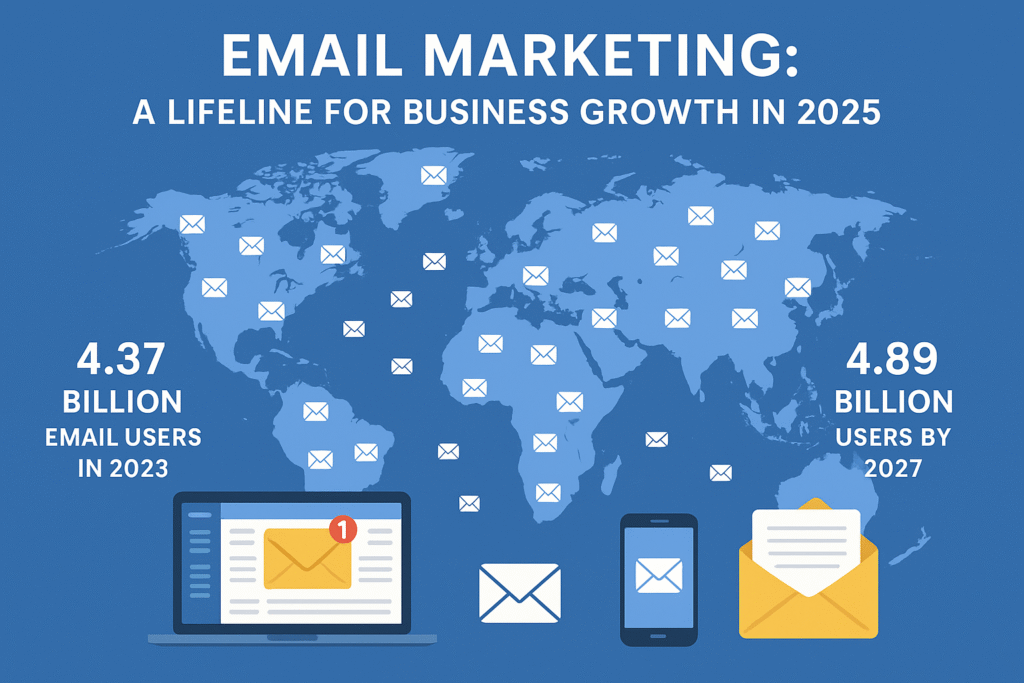
Here are some key numbers:
Email User Base & Volume:
- The count of email users worldwide hit 4.37 billion in 2023 and looks set to climb to about 4.89 billion by 2027 (Oberlo).
- When it comes to quantity, In 2022, approximately 333 billion emails were sent and received globally every day. This number is expected to grow to 392.5 billion daily emails by 2026, with ~120 of these being marketing messages (Statista). These numbers show why cutting through the inbox mess is a big hurdle for marketers.
Effectiveness & ROI:
- Email brings one of the highest ROI of any marketing channel. On average, email marketing gives back $36–$40 for every $1 spent, which means a 3600%+ ROI. This beats most paid ads by a long shot.
- It’s not shocking that 80% of marketers would rather ditch social media than email marketing if they had to pick – email is that crucial (Mailmunch).
- Also, 87% of businesses use email to share content (making it the second most popular channel after social media at 89%). Small businesses see email as their top ROI channel to get and keep customers.
Open Rates & Click Rates:
- Email engagement metrics differ by industry, but “good” performance often stays modest. The average email open rate across industries hovers around 25-30%.
- The average click-through rate (CTR) sits at about 2–3% – meaning a few percent of all sent emails get a click. For instance, emails sent through Constant Contact in 2025 had an average CTR of 1.36%.
- CTR ranks as the #1 metric marketers use to measure email campaign success. Boosting these rates remains an ongoing priority.
Segmentation & Personalization:
- Splitting up email lists and making emails personal work well. Emails sent to specific groups get 30% more opens and 50% more clicks than those sent to everyone. It’s clear why 78% of marketers think dividing their audience works best for emails (FluentCRM). Making emails personal (like using names or matching content) also helps: putting customer names in subject lines is common.
- AI is changing things – 95% of marketers who use AI to write emails say it works well (CampaignHQ). 43% of marketers using AI find it most useful for writing email content. These smart methods keep emails interesting and on-point.
Mobile & Deliverability:
- Mobile optimization plays a key role because around 41% of email views happen on mobile devices (and 75% of Gmail users check their emails on mobile). Yet, some businesses lag behind – about 1 in 5 email campaigns doesn’t work well on mobile, which can reduce engagement (PorchGroupMedia).
- Also crowded inboxes mean many emails go unread: 59% of Americans think most emails they receive aren’t helpful to them, and getting too many emails is a main reason people opt out.
- In 2025 effective email marketing depends on quality over quantity – focused messaging right timing, and designs that look good on mobile to boost conversion rates (which now average ~2.5% from email for B2C campaigns).
SEO and Organic Search Statistics for 2025
Search engine optimization (SEO) continues as a central component of online marketing in 2025, as organic search remains the primary way people find information and access websites.
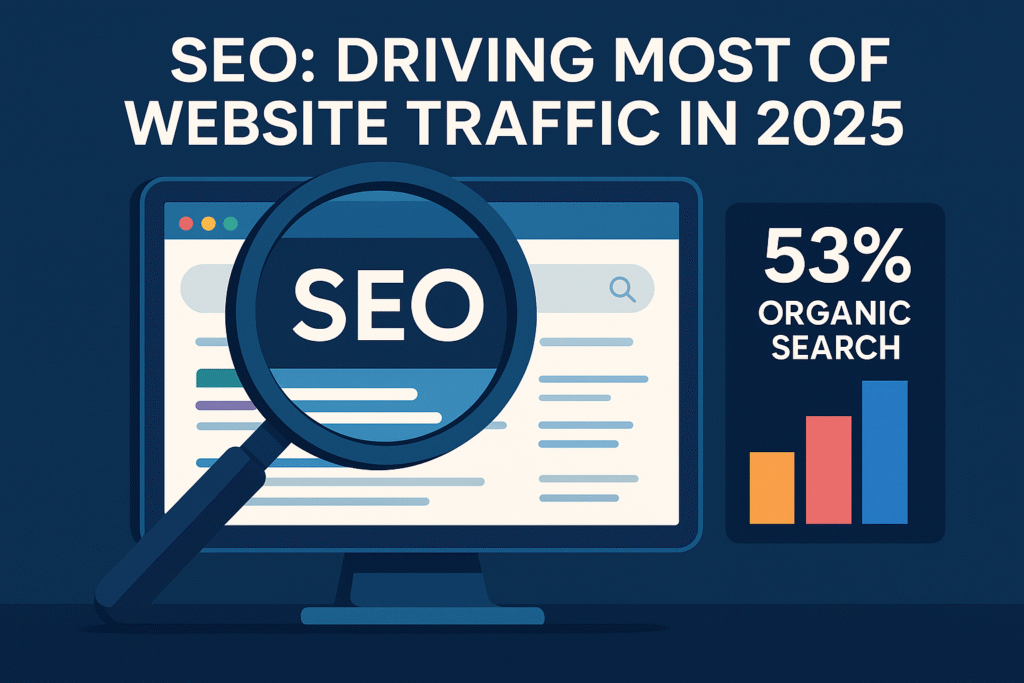
Here’s what the numbers and trends show for SEO:
Organic Traffic & Industry Size:
- Organic search has an influence on about 53% of all website traffic on average making it the biggest traffic source (far surpassing social or paid channels for many sites) (Brightedge). This shows why SEO matters so much.
- The SEO industry itself has a value of ~$90 billion in 2024 up from $75 billion in 2023 – this reflects how much businesses put money into search optimization and related tools/content.
Marketers’ Perspective:
- About 61% of marketers say getting traffic and leads is their biggest challenge, which SEO tackles head-on. Companies with blogs (a key SEO move) see 55% more website visitors than those without (Wordstream).
- Plus, brands that blog have 434% more pages indexed in search engines on average making them easier to find (Showit).
- As content and SEO plans change with AI, around 66% of businesses use AI tools to come up with ideas or draft content to boost SEO. But there’s some worry too: 25% of businesses are concerned about how AI might affect web traffic (like AI-generated search results maybe leading to fewer clicks).
Search Behavior Stats:
- 25% of people go to page 2 of Google results – meaning 75% of searchers stay on page one. This shows how important top rankings are.
- The #1 organic result gets an average CTR around 31%, while results lower on page one might see CTRs in the low single digits (a “good” average organic CTR is ~3–5%) (BackLinko).
- Zero-click searches happen often: about 50% of all Google searches end without a click (the user finds the answer right on Google). This trend pushes marketers to optimize for featured snippets and other on-SERP features to grab attention.
- ~46% of all Google searches look for local information (e.g. “near me” queries). Local SEO is therefore key for brick-and-mortar businesses – 28% of local searches lead to a purchase within 24 hours showing that local searchers often intend to buy.
Conversion & Lead Quality:
- SEO doesn’t just boost traffic; it brings in quality leads. SEO leads close at almost 14.6% (becoming customers) way above outbound leads like direct mail or print ads (SearchEngineJournal). It’s worth noting that 49% of businesses say organic search gives the best ROI of all marketing channels (backing up the ROI stats from before).
- Good rankings for relevant searches can create a steady flow of high-intent visitors at a lower cost than paid ads in the long run. This explains why 29% of marketers count SEO as a top trend/strategy they use and why big companies put tens of thousands of dollars each month into SEO work (Taboola).
Mobile & Voice Search:
- Mobile search now leads the way – mobile devices make up over half of web traffic worldwide (about 64%) and likewise, Google holds 93.82% of the global mobile search market (Statista).
- Voice search has become more popular: As of 2025, approximately 20.5% of people globally are using voice search (with smart speakers and voice helpers like Alexa). Yet 13% of marketers now optimize to handle voice search queries showing a possible chance to grow as more consumers turn to voice for their searches.
Content Marketing Statistics & Trends for 2025
Content marketing – creating and distributing valuable content to attract audiences – remains essential in 2025. Encompassing blogs, infographics, ebooks, and podcasts, it integrates with SEO and social media across all funnel stages.
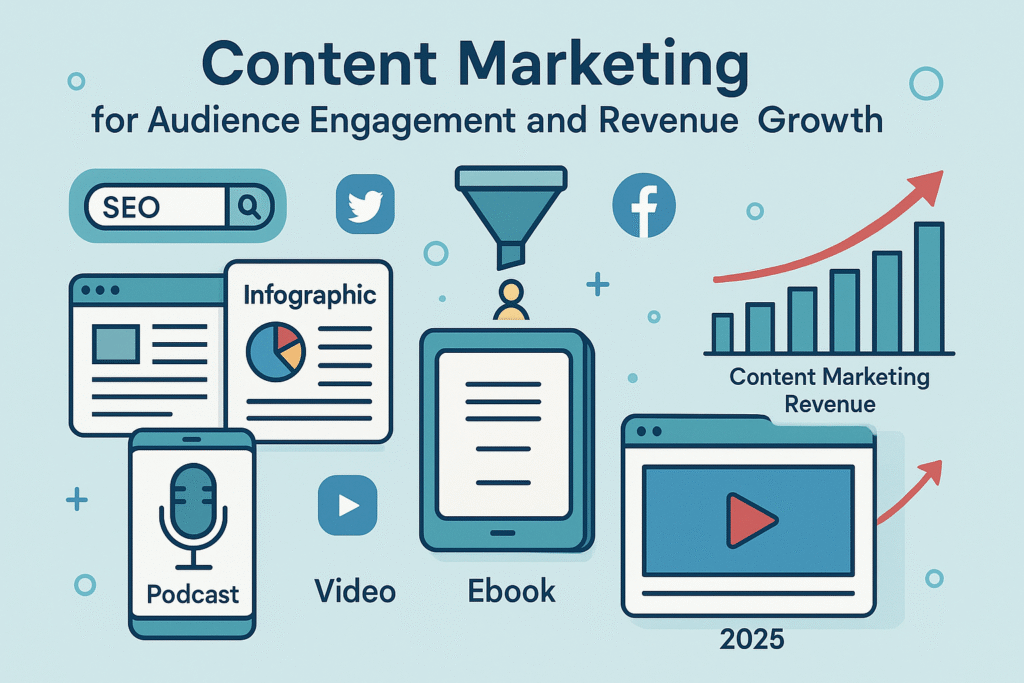
Key stats:
Prevalence and Investment:
- Many businesses use content marketing – about 29% of marketers apply content marketing strategies (HubSpot), and 50% of marketers plan to boost their investment in content marketing in 2024. (HubSpot Marketing Statistics)
- Experts predict global content marketing revenue will reach $107.5 billion by 2026 (Digitalsilk). Marketing teams focus on content because it delivers results: 74% of marketers report that content marketing helped create demand or leads for their company, and 49% say it boosted sales or revenue (Cropink).
Blogging and Articles:
- Blogs remain popular, though videos have grown faster. In 2024, 19.47% of marketers used blog posts making them the 4th most common content type (HubSpot).
- Short videos and images tied for first at 29%, while interviews came in second at 22%.
- Blog posts in 2024 averaged about 1,400 words – 77% longer than a decade ago showing a trend toward deeper content. Companies that blog often see much higher traffic (+55%) and more indexed pages (+434%), which helps SEO (Masterblogging).
- Good content also builds relationships with potential customers: 62% of marketers believe content marketing nurtures leads and audiences.
Content Types & Performance:
- Visual and interactive content is getting more popular. Short-form video (TikTok, Reels, YouTube Shorts) is now the top media format marketers use, and 21% of marketers say that short videos give them the highest ROI of any content type.
- Infographics are also in demand – 88% of marketers planned to keep or increase their spending on infographics in 2024, as they can boost web traffic by up to 12%. However, making good content is tough: 43% of marketers find it hard to produce high-quality visual content.
AI in Content Creation:
- AI tools in content marketing became much more popular. 54% of content marketers used AI to come up with ideas in 2024 (up from 43% the previous year). Yet a tiny number (6%) use AI to write full articles showing most see AI as a helper, not a replacement for human content creation.
- Also, one in two writers now use AI tools to boost content performance (like SEO improvement, title ideas). This trend suggests a growing “enhanced” content process where human creativity teams up with AI’s speed and efficiency (HubSpot).
Measuring Content Success:
- Marketers care about content metrics. More than 41% evaluate content success by the sales it generates showing how content needs to boost revenue. Other key indicators include website traffic (one of the top two measures) and lead quality.
- Content marketing supports other channels: for instance, 48% of social media marketers adapt or reuse content across platforms instead of always starting from scratch getting the most out of each piece.
Video Marketing Statistics & Trends for 2025
Video marketing dominates in 2025. Video content increases engagement and creates emotional connections with viewers – essential in the current digital environment.
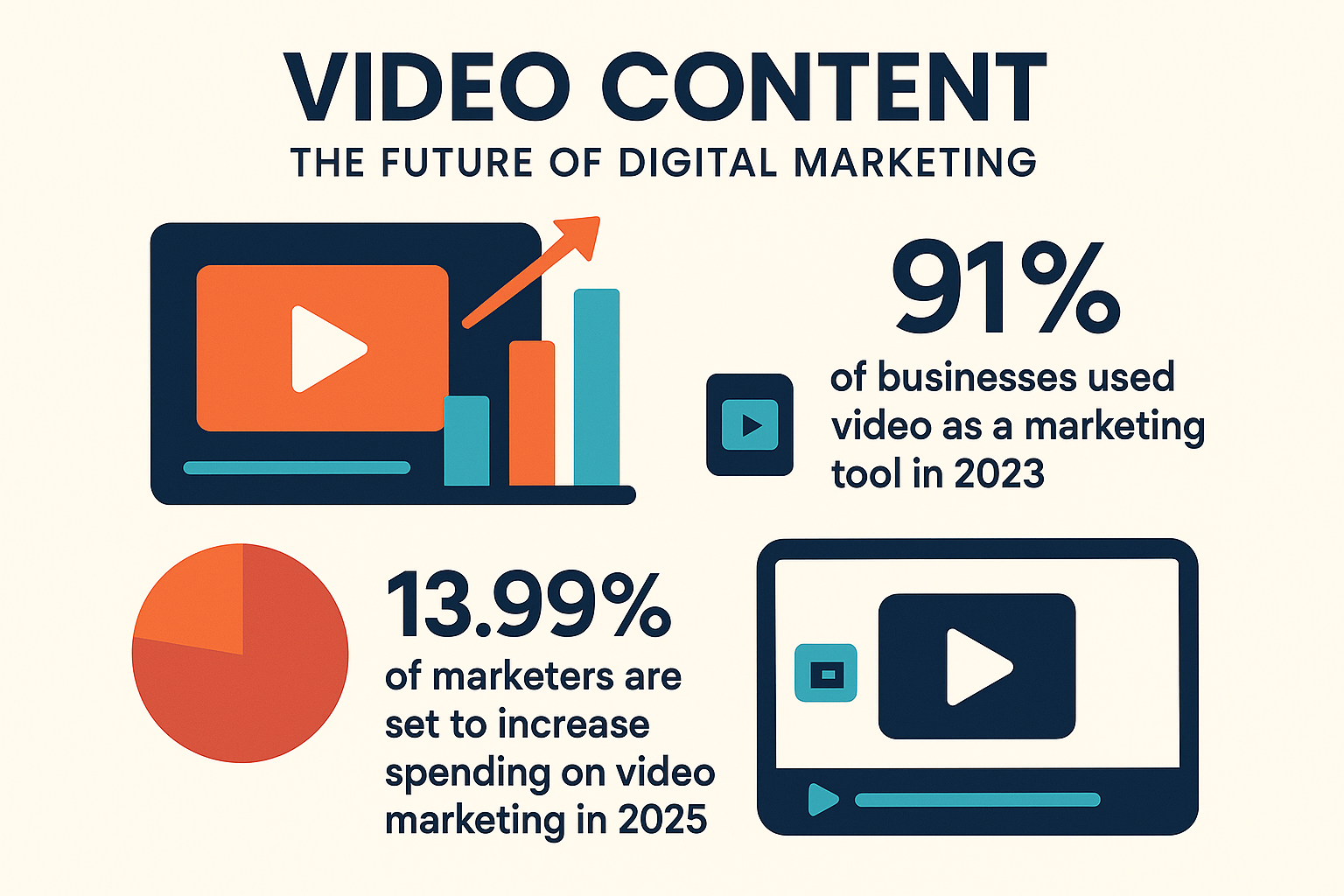
Here are the main video stats and trends:
Adoption & Usage:
- 91% of businesses used video as a marketing tool in 2023, and a significant 13.99% of marketers are set to boost their spending on video marketing channels in 2025.
- 89% of marketers who haven’t tried video yet plan to start in 2025, which shows that even those who haven’t jumped on board yet see video as essential. Because smartphones are everywhere and making videos is so easy even small businesses can create videos.
- Short videos (less than 60 seconds) are popular right now – they’re the most common type of video marketers use (29% use them), and they’re also the top format marketers want to focus on in 2025 (HubSppot).
Consumer Engagement:
- People like videos for learning and fun. 73% of consumers say they’d rather watch a short video to learn about a product or service than read text or use other methods. This explains why explainer videos and demos are so popular.
- Short-video platforms see high average engagement rates – for instance, YouTube Shorts has about a 5.9% engagement rate, and TikTok about 5.8%, which beats the usual engagement on longer content by a lot.
- People watch tons of video too: 69% of U.S. consumers say they use smartphones most to watch videos (more than computers). Video reaches consumers where they are and gives them content in a way they like.
Video Content ROI:
- Marketers see great returns from video content. 93% of video marketers claim video has a positive impact on their ROI. It shows better conversion rates – in fact, video marketers pinpoint engagement rate (60%), conversion rate (56%), and click-through rate (52%) as key metrics to measure video campaign success (HubSpot).
- Video ads also shine: one stat reveals video ads beat other ad types by 120% in engagement or effectiveness (Cropink). Plus, 21% of marketers say short-form videos bring the highest ROI (more than any other type of content).
Ad Spending on Video:
- Companies are investing in video advertising and content. Video ad spending will hit $207.5 billion in 2025, a big jump from recent years. This trend shows no signs of slowing, with estimates of $268 billion by 2029 for video ads (HubSpot). This covers platforms such as YouTube, Facebook/Instagram video, TikTok, and streaming services.
- Video ads can target specific audiences and people watch them more on their phones. By 2024, two-thirds (65.3%) of digital ad budgets went to mobile, with much of this money spent on video in social feeds and apps.
Optimal Video Strategies:
- New findings on video length and tactics are coming to light. It seems brevity wins: over a third of video marketers believe the ideal video length ranges from 1–3 minutes, and 96% think it shouldn’t exceed 10 minutes (HubSpot).
- For quick social videos, under 60 seconds is the norm (e.g. most TikToks last about 40 seconds). While live videos and webinars have their place short punchy content grabs more attention.
- On the production front, videos don’t need to break the bank: 42% of video marketers spend less than $500 per video proving that simple production can be effective. Regarding content types, explainer and product videos are key – 96% of people have viewed an explainer video to understand a product, and 89% have been persuaded to buy after watching a video.
- It’s no surprise that 96% of marketers say video has helped users better understand their product. The data-backed conclusion is that video brief and explanatory content, is a powerful, cost-effective strategy in 2025.
Influencer Marketing Statistics & Trends for 2025
Influencer marketing – partnering with social media personalities or content creators – has become integral to digital marketing in 2025. It uses data on engagement, reach, and conversion, typically complementing social media strategies.
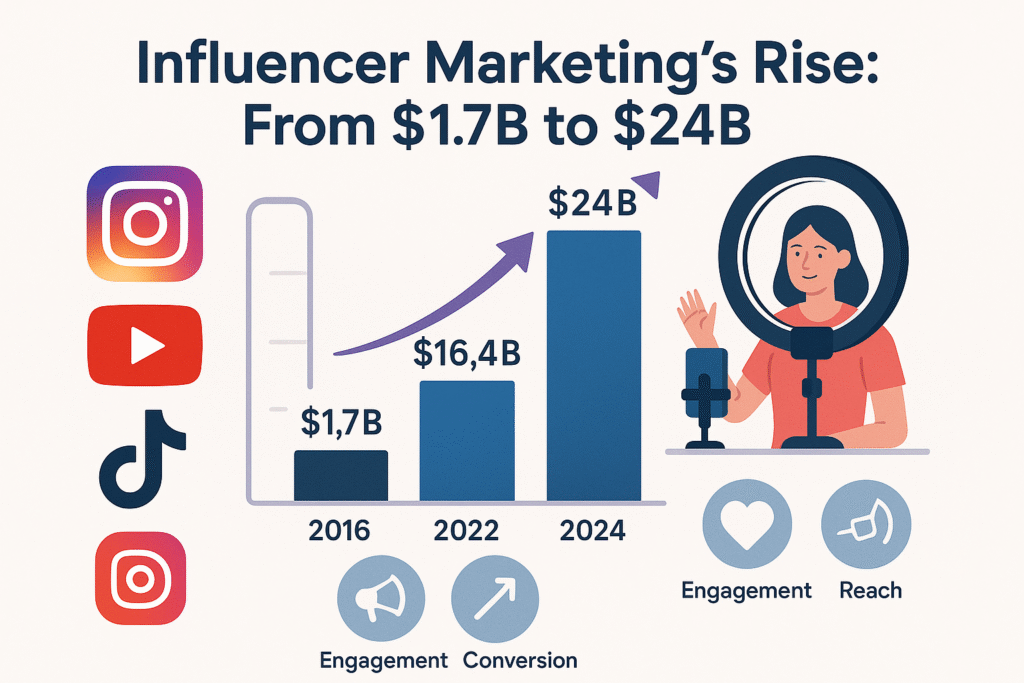
Here are some key stats:
Market Growth:
- The influencer marketing industry has had an exponential influence on growth, from an estimated $1.7 billion in 2016 to $16.4 billion in 2022, and then $24 billion in 2024 (SproutSocial). Experts predict it will keep booming – projections show the industry reaching about $32–33 billion in 2025.
- This includes money spent to partner with influencers, run campaigns, and the boom of influencer platforms/marketplaces. It’s worth noting that even the influencer marketing platform/software industry by itself is expected to reach $33 billion by 2025 showing the range of tools to find and manage influencers.
Adoption by Marketers:
- Influencer marketing has become common for consumer brands. In the U.S., 86% of marketers will use influencers in 2025 (among companies >100 employees). This number has gone up from about 70% just a few years ago.
- Many brands spend a lot on influencers – as of 2024, 26% of marketing agencies/brands put over 40% of their marketing money into influencer campaigns. (But another ~26% spend less than 10% showing different approaches.) These numbers prove that many companies see working with influencers as a smart way to reach people on social media.
Preferred Platforms & Influencer Types:
- Instagram still tops the list for influencer marketing – 57% of brands say Instagram has their preference for influencer campaigns, with TikTok following at 52%, and YouTube at 37%. This matches Instagram’s visual appeal and well-established creator community.
- When it comes to influencer levels, micro-influencers (with 10k–100k followers) and nano-influencers (1k–10k) play a crucial role: they make up most of the influencer pool (micro-influencers account for about 47% of all influencers) and often show better engagement (nano-influencers see an average 2.19% engagement rate beating mega-influencers). Brands now look more to these smaller specialized creators to build genuine connections (thesocialshepherd).
ROI and Effectiveness:
- Influencer marketing has an influence on impressive returns when done right. Companies earn an average of $6.50 for every $1 they put into influencer marketing, according to one study – a 550% ROI.
- The top 3% of campaigns bring in $20+ per $1 spent. This beats many traditional ad channels. To compare, influencer marketing has 11 times the ROI of banner ads (banner ads being a more passive form of advertising) – showing how using an influencer’s trusted voice can boost returns.
- Beyond sales, influencers attract “better” customers: 51% of marketers say influencer marketing helps them get higher-quality customers (more loyal or with higher LTV). This could stem from the targeted, trust-based nature of influencer referrals.
Consumer Impact:
- Influencers have a notable impact on consumer behavior among younger age groups. About 4 in 10 social media users have bought something after an influencer recommended it. To be exact, 39% of all adult social users say creators have an influence on their buying choices to some degree.
- This effect is much stronger for young adults: 54% of users aged 18–29 say influencers shape their purchases, compared to 42% of those 30–49 (socialshepherd). Trust plays a key role – 67% of consumers believe the best brand-influencer partnerships are those that remain honest and unbiased.
Trends in Influencer Campaigns:
- Short-form video (15–30s) stands out as the top content format for influencer collaborations, with 53% of influencers naming it their favorite type of brand content to create. This mirrors broader social media patterns.
- influencers seek deeper involvement – 65% of influencers prefer to take part in a brand’s creative process or product development instead of just following a rigid brief. This indicates brands that team up with influencers in the creative process might achieve better outcomes.
- For marketers engagement metrics serve as the main yardsticks to measure influencer campaign success (68% track likes/comments, etc., and 50% monitor referral traffic). Overall, influencer marketing in 2025 has grown into a refined practice with big budgets, quantifiable returns, and a focus on authentic partnerships that strike a chord with target audiences.
Conclusion
The digital marketing landscape in 2025 is data-driven, multi-channel, and dynamic. Marketing professionals succeed through fact-based approaches that incorporate continuous measurement, learning, and strategy adjustments based on trends and real-time data. Companies that leverage marketing automation and data-driven insights will be in the best position to identify emerging trends, adapt quickly, and achieve significant results.
Accurate data enables marketers to refine strategies confidently, maximizing each dollar’s impact on brand awareness and ROI. Focusing on mobile advertising, search advertising, and cross-channel optimization helps brands maximize reach and effectiveness in 2025’s competitive landscape. In this dynamic environment, proactive, data-centric companies consistently outperform those failing to adapt to the evolving digital marketing landscape.
FAQs
1. How can data-driven trends impact my SEO marketing strategy?
Incorporating data-driven insights into your SEO marketing strategy helps you identify what’s truly working in your organic efforts. By measuring search performance and user behavior, you can optimize your content and make better decisions that increase visibility, boost traffic, and improve conversions.
2. What role does mobile advertising play in the digital marketing world?
Mobile advertising continues to rise, with social media advertising playing a key part in this shift. With mobile-first indexing becoming more prominent, focusing your digital marketing efforts on mobile platforms ensures that your campaigns are reaching audiences on the go, increasing your chances for higher engagement and better results.
3. How do social media advertising statistics help refine my marketing strategy?
Social media advertising statistics provide valuable insights into what types of ads work best on various platforms. By analyzing these stats, you can fine-tune your social media platform choices and ad formats, ensuring that your campaigns are targeted, cost-effective, and capable of driving more conversions.
4. Why should I focus on the global digital marketing industry for my business?
The global digital marketing industry is rapidly expanding, with trends shifting towards more targeted, data-centric approaches. Staying updated on these changes ensures that your business doesn’t miss out on new opportunities and allows you to allocate resources effectively across various digital marketing channels.
5. How do social media platforms impact the success of online advertising?
Social media platforms are crucial for online advertising, as they offer robust targeting features and vast user bases. By leveraging the right platform, you can optimize your digital marketing efforts to ensure that your ads are reaching the most relevant audience, maximizing your ROI.
6. What are the most effective types of online advertising in 2025?
In 2025, online advertising continues to evolve, with social media advertising taking center stage due to its ability to engage and convert targeted audiences. With better data insights, social media advertising strategies can be tailored to enhance brand visibility and drive higher conversion rates.

Shalini Nagar is an experienced content writer with a proven track record of creating diverse and engaging content across various formats. With years of expertise in crafting blogs, articles, she excels at delivering compelling narratives tailored to different audiences.
